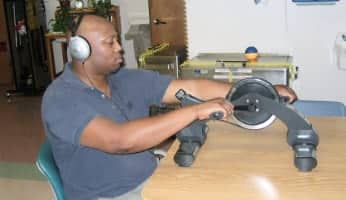Richard’s Parkinson’s Revival: Rediscovering Mobility with Interactive Metronome

Home - Testimonials - Adult Testimonials - Richard’s Parkinson’s Revival: Rediscovering Mobility with Interactive Metronome

Richard’s Parkinson’s Revival: Rediscovering Mobility with Interactive Metronome
Richard is 81 years old and was diagnosed with Parkinson’s disease in 2001.
He was referred to physical therapy secondary to complaints of increasing difficulty initiating mobility, resulting in difficulty transferring, walking, performing activities of daily living, and hobbies including bowling and golf.
Richard currently lives in an assisted living facility. He reports that he has fallen five times in the last year.
Assessment
Transfers: Richard was able to transfer from supine-to-sit independently if provided with extra time. Sit-to-stand transfers required standby assistance for safety and cues for anterior weight shift. Richard had difficulty initiating steps when moving from sitting on a mat to another surface. When he first stood, he took several shuffling steps to regain his balance.
Ambulation: Richard ambulated with an assistive device, although it was recommended that he use a cane or walker for safety (he chose not to. He was able to ambulate 400 feet and took short, shuffling steps when initiating gait. Richard lacked a heel strike on the left foot at initial contact of stance phase. He is able to step over obstacles smoothly if already walking, but cannot accomplish this task if asked to perform from standing. His steps are shuffled and disorganized, and Richard was unable to clear the obstacle.
Goals: Richard’s goals are to avoid falling, continue golfing, and “not be so stiff” when he first moves.
About the Gait Mate
The Gait Mate is a therapy modality for improving a patient’s:
- Stride Length
- Heel Strike
- Gait Stamina
- Weight Shifting
- Quality of Movement
It is an extension of the Interactive Metronome which has been used by Physical and Occupational Therapists for almost ten years to assess and treat motor planning, sequencing, coordination and balance.
The Gait Mate makes IM’s formerly static exercises more functional and allows the patient to work on these neurological processes while walking around the gym or up and down the hall. The therapist inserts a wireless insole into the patient’s shoe that detects when the patient performs a heel strike. The patient hears a beat through wireless headphones or speakers and is asked to match the cadence provided.
The Gait Mate provides the patient with auditory feedback as they walk instructing them to speed up if they are walking too slowly or to slow down if they are shuffling or dropping their foot too quickly. The patient receives no positive feedback if his/her heel doesn’t strike the ground.
Treatment
Richard was seen for 12 treatment sessions and the treatment plan consisted of stretching, strengthening, balance retraining, and patient education.
The Interactive Metronome (IM) and Gait Mate were incorporated to improve coordination, balance, motor control, and timing.
Outcome
Richard was seen for 12 treatment sessions, and IM and/or Gait Mate were used each session. Richard performed a minimum of 700-800 repetitions with IM/Gait Mate each session.
He reported feeling like his walking had significantly improved with less freezing episodes and he had returned to bowling, golfing, and participating in group exercise classes.
Richard now ambulates on all surfaces with modified independence. He does not use any assistive device.
Shelley Thomas, MPT
Idaho Elks Rehab
Boise, ID




